

April 23, 2010
Dear Brethren,
Sometime ago, I began a historical writing of the 7 Church Eras. Though I have only completed the letter to the Ephesian Church Era, I hope to begin work again soon with the remaining ones. With the comments for this time I will present the introduction to them.
This is the second of a three-part series of the Ephesian Church Era. It may be some time before I can complete the writing of each Church Era, but this one is ready to present to you.
While studying this particular Era over the past few years, I have felt the troubling problems of the apostasy that confronted that early Church is very probably the most similar to the recent history of the Philadelphia Era of our time—since 1986—and should be thought about in that context when studying it for yourself.
Your brother and fellow-laborer in God’s Harvest,
Don Billingsley
The History of God’s One and Only True Church
By Alton (Don) B. Billingsley
Part 2
The Ephesian Era
Regarding the establishment of His Church, Jesus Christ said to the apostle Peter and the rest of His disciples
“. . . On this ROCK (Greek: Masculine, Petros, Feminine, Petra, meaning Jesus Christ Himself, Deuteronomy 32:3-4; I Corinthians 10:4) I will BUILD My Church, and the gates of Hades (graves, I Corinthians 15:54-55) shall NOT prevail against it.” (Matthew 16:18).
Continued from 4-16-2010
Addressing Each Church by Name
Jesus Christ addresses each Church Era by saying: “And to the angel” (Margin: or Messenger), appears to be synonymous with the apostle of each Church era; and the messenger, or apostle, reflects the Spiritual state of each Church Era.
History reveals the Church is only as strong and zealous as is the messenger. Think of this in regard to the apostles, Peter, Paul, and John of the Ephesian Church Era; and Mr. Herbert W. Armstrong the Philadelphia Era in this end-time of the Church of God. He held the majority of the Church together and on track until his death in 1986 (II Thessalonians 2:6).
In addition there is the need of connecting THE NAME of each Church era to its place in history at that time for the name reveals the major weaknesses of each era. Their major weaknesses are also made known by what Jesus Christ says about them in each letter.
These two chapters (Revelation 2 and 3) will be considered more in detail in this present writing (NKJV).
Introduction to the Ephesian Church Era
The Apostolic Church
The Church at Ephesus - The loveless Church - 31-135 A.D.

Background
of the City of Ephesus
Ephesus was the commercial capital and primary city of western Asia Miner.
It was a Roman province in Asia. Today it is known as Asia Minor – Turkey.
It was a magnificent city of a population of 225,000. It was at the center of the Imperial Highway from Rome to the East. It was the backbone of the Roman Empire (Acts 19).
Ephesus became the metropolis of the Churches in Asia Minor and became another headquarters of the Ephesian Era. After having been released from the island in Patmos in the 90s, the apostle John returned to Ephesus.
While dwelling in Ephesus the apostle John trained Polycarp who later carried forward the Work of John and Philip. Polycarp trained Polycrates, who replaced him (more about these two men later). It was here that the apostle John, and the original deacon, Philip died.
The name of Ephesus means, ‘Desirable’, and it was for the Church Era in its beginning years of 31 A.D., but over the next 20 years or so, it came to be loveless and as the result Jesus Christ removed its candlestick.
The
Letter from Jesus Christ to the Church in Ephesus
“And to the angel (Margin: Messenger) of the Church in Ephesus, write:
‘These things says He who holds the seven stars in His right hand, who walks in the MIDST of the seven golden lampstands, which you saw are the 7 Churches (Explanation given in Revelation 1:12, 16).
Jesus Christ speaks of its good points and commended them for them:
“I know your works, your labor, your patience, and that you CANNOT BEAR those who are evil. And you have TESTED those who say they are apostles and are not, and have found them liars. . . . But this you have, that you hate the deeds of the Nicolaitans, which I also hate” (Revelation 2:2, 6).
Though it did have its good points; it was in this very first Church Era that a major problem developed. And because it was not corrected its lamp was removed by Christ (verse 5). Sadly this problem filtered on down through all of them until the Philadelphia Era.
What was that grave problem?
Christ said through John: “Nevertheless I have this against you, that you have LEFT your first love” (Revelation 2:4).
The First Love
T hat
FIRST LOVE was the caring desire to share the wonderful truths of the
gospel with others!
hat
FIRST LOVE was the caring desire to share the wonderful truths of the
gospel with others!
This was that same LOVE with which they were blessed in their initial conversion by having had their minds OPENED to receive those truths from God our Father and Jesus Christ.
This can be seen by those who were brought to conversion on the Day of Pentecost in 31 A.D., and sometime afterwards:
Then those who gladly received his word (from the apostle Peter) were baptized; and that day about three thousand souls were added to them (120, Acts 1:15). And they continued steadfastly in THE APOSTLE’S DOCTRINE and fellowship, in the breaking of bread and prayers. . . . Now all who believed were together, and had all things in common (sharing, see Acts 4:32-35) . . . they ate their food with gladness and simplicity of heart, praising God and having favor with all the people. . . . (Acts 2:41-47).
The
Church was scattered in 33 A.D., but it was still zealous for they
went everywhere preaching the word (Acts 8:1, 4; 11:19). But this
first love began to fade into the background during
the
following few years.
Major Problems Resulted
The writings of the apostles Peter, Paul, John, and Jude, reveal that the following few years their love had faded so much it had come to be an almost total loss; and with that loss of love, major problems had developed. This can be seen in the writings of the apostle Paul to the Churches in Galatia, Corinth, and elsewhere.
The blessing of that first love was overpowered by both the acceptance of false teachers, and ministers who turned apostate (Acts 20:29-30). As the result the entrance was made easy for erroneous teachings and the majority of its members embraced them.
A few remained faithful, but from the context of what was written to the Ephesian Church Era, it appears the majority did not remain faithful; and Christ removed its lamp.
Simon Magus
The major instrument Satan the devil used to bring about the pagan teachings that entered the Ephesian Church Era, was a man named Simon Magus.
Though more will be written about this man who was baptized by Philip, but was denied the laying on of hands for the receiving of God’s Holy Spirit (Acts 8:9-23); it is sufficient to say here that he was the instrument of Satan the devil and used by him to begin the Catholic Church. He is introduced here in brief:
Simoni Deo Sancto
“Justin and Irenaeus also record several other pieces of information: After being cast out by the Apostles he came to Rome where, having joined to himself a profligate woman of the name of Helen, he gave out that it was he who appeared among the Jews as the Son, in Samaria as the Father and among other nations as the Holy Spirit. He performed such miracles by magic acts during the reign of Claudius that he was regarded as a god and honored with a statue on the island in the Tiber which the two bridges cross, with the inscription Simoni Deo Sancto, "To Simon the Holy God". However, in the 1500s, a statue was unearthed on the island in question, inscribed to Semo Sancus, a Sabine deity, leading most scholars to believe that Justin Martyr confused Semoni Sancus with Simon.”
T he
followers of Simon Magus (Acts 8:9-24) had already infiltrated into
those Churches of God and had taught the same teachings as do the
Christian Churches today. They were tolerated by some of the leading
ministers and members who felt they would not be showing love if they
did not—and perhaps they would come to see their errors and
change (I Corinthians 5:1-13). It didn’t happen!
he
followers of Simon Magus (Acts 8:9-24) had already infiltrated into
those Churches of God and had taught the same teachings as do the
Christian Churches today. They were tolerated by some of the leading
ministers and members who felt they would not be showing love if they
did not—and perhaps they would come to see their errors and
change (I Corinthians 5:1-13). It didn’t happen!
The faithful members of that Church Era were commended by Christ for their perseverance and for TESTING the ministers among them who were in reality ministers of the synagogue of Satan the devil.
“I know your works, your labor, your patience (margin: perseverance), and that you cannot bear (margin: endure) those who are evil. And you have TESTED those who say they are apostles and are not, and have found them liars” (Revelation 2:2
The Gospel of Jesus Christ, the Messenger
By A.D. 53— the false ministers had also infected some of the leading ministers and members in Galatia by changing the correct teaching of the Gospel from what the Messenger, Jesus Christ, had brought to mankind, to that about the person of Jesus Christ:
“I marvel that you are turning away so soon from Him who called you in the grace of Christ to A DIFFERENT GOSPEL (Galatians 1:6-9).
Mystery of the Ages, Chapter 7, Mystery of the Kingdom of God, pages 293-294
“During the first 20 or 30 years after the founding of the Church in A.D. 31 a violent controversy arose over the very question of what is ‘the Gospel of Jesus Christ.’ There ensued a hundred years in which all history of the New Testament was destroyed. It has been called ‘the lost century of Church history.’ When the curtain lifted, about the middle of the second century, there appeared an entirely different church calling itself Christian, but in the main preaching its own gospel about Christ [Himself], not the gospel OF Christ.”
During this time the Church Era of Ephesus had actively ceased carrying God’s TRUTH to the world. It went to sleep spiritually. From about A.D. 59 the gospel was suppressed. A counterfeit gospel replaced it (Mystery of the Ages, Pages 293-294).
It was also during this time that the Churches in Asia began falling away as the apostle Paul makes known: “This you know, that all those in Asia have turned away from me . . .” (II Timothy 1:15). This was undoubtedly very discouraging for the true membership. Possibly this was in type what happened with God’s Church after 1986.
After both encouraging and urging the members of God’s Church to be faithful to their calling in their last letters (II Peter 1:10-15; II Timothy 1:13-14; 4:6-8), the apostles Peter and Paul were martyred in 68 A. D. This was also the same year that Emperor Nero of Rome committed suicide (June 9th, 68 A.D.).
The Church in Jerusalem Flees—
B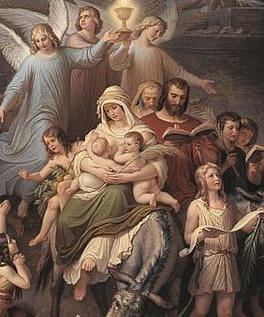 etween
the years of 69 A.D. and 70 A.D, the members of the Church of God who
were dwelling in Jerusalem fled from that city to Pella, Jordan, to
escape the slaughter the Jewish people experienced upon the arrival
of Titus and his Roman armies and their attack against that city.
etween
the years of 69 A.D. and 70 A.D, the members of the Church of God who
were dwelling in Jerusalem fled from that city to Pella, Jordan, to
escape the slaughter the Jewish people experienced upon the arrival
of Titus and his Roman armies and their attack against that city.
To try and pinpoint as closely as possible the actual time the Church fled, references will be used primarily from the writings of the very famous and respected Jewish historian, Josephus.
Josephus— ANTIQUITIES OF THE JEWS
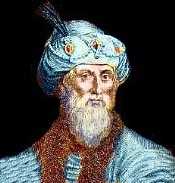
THE JEWISH WAR, Volume 4, Book IV, chapters 9- 11; Book V, chapters 1-3.
The Jewish Rebellion Against Rome
In Jerusalem “. . . mounting anger broke into open revolt against Rome in May, 66 A. D. . . . This was the signal for the whole country. Rebellion flared up everywhere,” The Bible as History by Werner Keller.
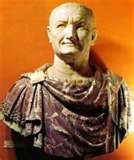 Rome
fought back. The Jews were victorious for a time; however the armies
of Rome over the next three years proved to be too much for the Jews.
City after city was taken by the Roman General Vespasian’s
armies until they reached Jerusalem and began making preparations to
conquer the city in 68 A.D.
Rome
fought back. The Jews were victorious for a time; however the armies
of Rome over the next three years proved to be too much for the Jews.
City after city was taken by the Roman General Vespasian’s
armies until they reached Jerusalem and began making preparations to
conquer the city in 68 A.D.
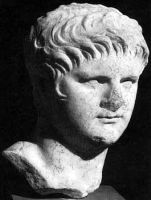 After
personally making the preparations for the attack against Jerusalem,
Vespasian then returned to Caesarea and was making ready with all his
army to march directly to Jerusalem. He then learned of the suicidal
death of Nero (June 9, 68 A.D.) and
changed his intentions of beginning the attack against that city.
After
personally making the preparations for the attack against Jerusalem,
Vespasian then returned to Caesarea and was making ready with all his
army to march directly to Jerusalem. He then learned of the suicidal
death of Nero (June 9, 68 A.D.) and
changed his intentions of beginning the attack against that city.
V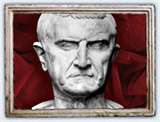 espasian
stood [waited] to see whether the empire would be transferred.
espasian
stood [waited] to see whether the empire would be transferred.
He heard Galba was made emperor and attempted nothing further till he should send him some directions about the war [June 68 A.D.]. With this in mind he sent his son Titus to salute Galba as the new emperor and receive instructions about the Jews. However Galba was slain before he arrived [January 15, 69 AD].
O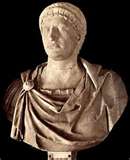 tho
then became the new emperor [January 15, 69 AD - April 16, 69 AD].
Titus hurriedly returned to his father in Caesarea.
tho
then became the new emperor [January 15, 69 AD - April 16, 69 AD].
Titus hurriedly returned to his father in Caesarea.
While Vespasian and Titus were waiting there an internal struggle broke out again near Jerusalem by the Jews against Rome
Vespasian and Titus fought back; and after they had overthrown all the places near Jerusalem; he returned to Caesarea. They heard further of the continuing troubles that were in Rome; and that Vitellius was now emperor [April 17, 69 AD]
T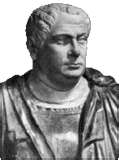 his
produced indignation in Vespasian; his passion excited him to avenge
his country. Because it was still the winter season he restrained
himself . . .
his
produced indignation in Vespasian; his passion excited him to avenge
his country. Because it was still the winter season he restrained
himself . . .
Afterwards Vespasian left Caesarea and came to Antioch on his march to Rome.
Vitellius had his head cut off by Vespasian’s troops in the midst of Rome, having reigned eight months and five days [December 20, 69 AD].
As
Vespasian was come to Alexandria this good news came to him from
Rome. And upon confirmation of him being established as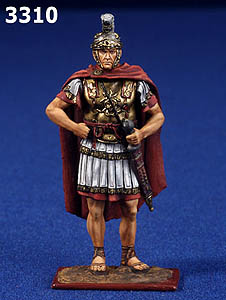 the new
emperor by his entire government he turned his thought back to the
unsettled state of Jerusalem.
the new
emperor by his entire government he turned his thought back to the
unsettled state of Jerusalem.
However, he himself made haste to go to Rome, since the winter was now almost over [69 A.D and early in 70 A.D.], and soon set the affairs of Alexandria in order.
While he was assisting his father in settling the government in Alexandria which had been newly conferred upon them by God, it so happened, that the sedition at Jerusalem was revived, and parted into three factions, and that one faction fought against the other.
Vespasian then sent his son Titus [from Alexandra] with a select army to destroy Jerusalem. So Titus marched on foot the many miles until he at last reached Caesarea.
After having reached Caesarea with his select army, Titus then gathered his forces together and ordered the others to meet him at Jerusalem. He then marched out of Caesarea toward Jerusalem.
To be Continued
http://bodyofchristonline.us/ http://cog-ff.com http://www.ezekielwatchman.org/
